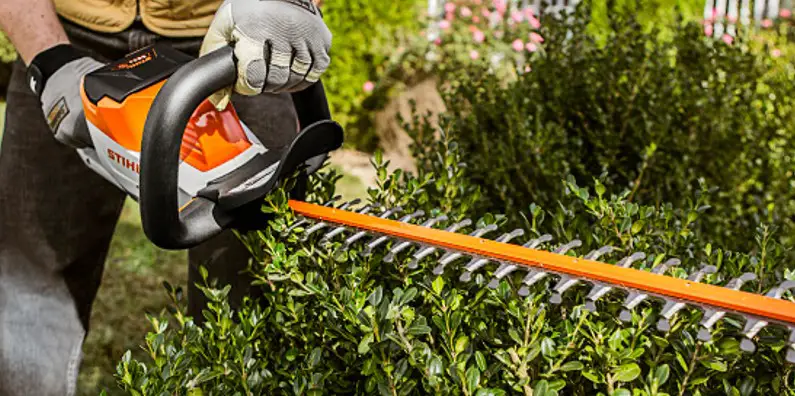Power tools are great, aren’t they? We can get so much more done, and in a fraction of the time! They take the hard work out of gardening, allowing us more time to appreciate the results.
Hedge trimmers are just one of these tools, and they are amazingly effective. Imagine doing the same job using hand shears, and you’ll have an idea of how useful they are.
However, they need to be handled with caution and care, or the results can be dangerous – even fatal. Out of the 300,000 odd garden accidents reported each year in the UK, more than 3,000 involve a hedge trimmer.
Reports include cases of electrocution and severe lacerations, some of which have resulted in death.
So, what can you do to ensure that you don’t add to these statistics?
Take a look at our hedge trimmer safety tips to learn how to reduce the possibility of harm to yourself and your family.
Safety Equipment
It’s tempting to ignore advice about wearing protective clothing. After all, we’re only gardening, so what could go wrong? And for those who recall the 1970s, before health & safety became a thing, few people ever wore anything like that and they were fine. At least, that’s what we like to think!
However, the truth is that accidents did happen, and they still do. It’s wise to take necessary precautions to prevent injury. Why take the risk when there’s plenty of opportunity to avoid getting hurt?
Here are some items that you should consider:
Protective gloves
While you may have been advised to never wear gloves when using power tools, this doesn’t apply to a hedge trimmer. An angle grinder or anything that rotates, definitely, as there’s a real chance that a glove could become caught in the mechanism, but with tools that have two operating handles (like hedge trimmers and chainsaws), they are highly recommended.
Always go for heavy-duty ones, but make sure they are a good fit. Over-sized gloves will be a hindrance and will stop you from holding the hedge trimmer securely.
It’s important to wear them while operating the machine as well as when you are inspecting the blades to avoid cutting yourself.
They will also protect against cuts and scratches from twigs while you are working.
You can pick up a decent pair for between £10 and £20, so there’s no excuse!
Safety Goggles
Many people don’t see the need for safety goggles when using a hedge trimmer. However, the reciprocating blades are powerful and may send a flying twig straight into your face at high speed.
Is it really worth risking your eyesight for the sake of putting on a pair of goggles?
Again, a good pair costs around £10, and this is a sound investment in your future health.
It’s also best to wear sturdy footwear rather than sandals or flip-flops and avoid wearing loose, baggy clothes that could snag on branches or get caught in the blades.
Protection is there for your benefit, so be sure to take advantage of any that’s available!
Preparation
Before beginning any job, check the working area thoroughly for any hazards or obstacles.
Here’s an idea of what to look out for:
Clear the area of any obstacles.
Including hoses, toys, rubbish, and plant pots. Most of the recorded garden accidents each year are from trips and falls involving pots that people didn’t see!
Children.
Keep any kids well out of the way. While they might want to help, it’s best if they are restricted from coming within about 40 feet of you (ideally, you should make sure everyone stays out of the way, not just kids!). Children should never be allowed to operate it under any circumstances.
Check bushes for hidden hazards.
Old fence posts tucked away inside hedges can damage the tool and may cause you to drop it or send you off balance. Also, you need to check for nesting birds. Not only is it an offence* to disturb or damage them, but it also could be a hazard if an alarmed parent bird suddenly launches itself from the hedge. You should also pull out any loose debris and branches or twigs that might snag on the blades.
*Under the Wildlife and Countryside Act 1981
Keep pets out of the way.
The last thing you need is a curious dog tripping or knocking you down, or distracting you as you sweep a razor-sharp blade around.
Never Operate A Hedge Trimmer Under The Influence!
It shouldn’t need saying, but it’s not the best idea to drink alcohol and then decide to trim the shrubs and bushes. You need to be relatively fit and healthy, with a clear head and sharp mind so that you are alert to any potential hazards.
Electric Hedge Trimmers
There’s an increased risk of electric shock when using these. However, all good brands will be double insulated. You should also ensure that your home has an inbuilt circuit breaker and RCD (residual current device) to lower the chance of electric shock.
Keep the cable well behind you over your shoulder while working, as this will stop you from cutting through it accidentally.
Your hedge trimmer may also require an extension lead. Ensure that it is fully unwound before starting the machine, and make sure that it is away from any water source, such as ponds or pools.
Always Ensure Secure Footing
Your posture is important! You need to stand with your feet planted firmly, a comfortable distance from the hedge to avoid overreaching.
NEVER raise the hedge trimmer above your head. If your hedges are higher than five feet or so, use a set of steps or a ladder that’s specifically designed for garden use.
In fact, it’s best to use these anyway so that you can reach the top of the hedge safely.
Keep in mind that the typical step ladder is not suitable; the feet will sink into the soft ground, putting you in danger while you are standing halfway up.
For your safety, consider investing in a tripod ladder. These are splayed at the base and are much more stable than ‘A-frame’ ladders, allowing you to work safely at height.
When working at ground level, never walk backwards while operating a hedge trimmer, as there’s a good chance that you’ll trip.
Avoid Working In Wet Weather
While the Great British Summer makes this difficult, it’s never a good idea to use a hedge trimmer when it’s tipping down. This is especially important when using an electric hedge trimmer, for obvious reasons!
However, even petrol and battery-powered machines won’t operate as well, so the results will be poor. Also, wet conditions increase the chance of slipping!
Wet hedges can potentially be cut after the rain has stopped, but it’s still best to avoid doing this with an electric hedge trimmer with a power cord.
Maintenance
Always choose the best model and make that you can afford. Ideally, pick one with an adjustable handle that allows you to cut at different angles without having to twist unnaturally.
Maintain your hedge trimmer to keep it in good condition and always repair any damage immediately. Pull out any debris that gets stuck between each blade.
ALWAYS switch off the hedge trimmer before checking or maintaining it. Ensure that electric trimmers are unplugged, remove the spark plug from petrol-driven models, and take out the battery from devices that use them.
You’ll need to lubricate the trimmer well and keep the blades sharp. Wipe it down after each trimming session, spray it down with WD40 (or similar), and store in a dry place.
And Finally…
Read the manual and maintenance guide before using your hedge trimmer!
It’s essential that you pay attention to safety advice for your own protection as well as your loved ones. It’s never worth putting yourself in peril, especially while performing a basic task such as trimming hedges!
Do take heed of these tips, as they are designed to protect you and limit the possibility of injury. And they might just save your life.


